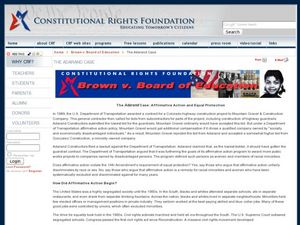Curated OER
What is Due Process Anyway?
Students examine the term due process and its historical origins. They compare and constrast the requirements of due process in the United States Constitution and the Indiana Constitution. They also discuss the difference between...
Alabama Learning Exchange
Creating a Psychology News Wiki
If you're searching for a way to keep your class informed of current psychology news, this ongoing assignment is both educational and engaging. Class members locate and read a psychology article of interest, write a psychological...
Curated OER
Follow the Leader
Here is a phenomenal lesson on the three branches of government for your second and third-graders. It presents this often-confusing information in an easy-to-understand format. Many excellent activities and worksheets are embedded in the...
Curated OER
4-H Citizenship Activity Page - Beginning Level
This is a 4-H citizenship activity that asks learners to examine county government, city councils, the three branches of the United States government, and complete a community service project. It also includes a word search,...
Curated OER
Civil Rights Leader: Rosa Parks
All humans should have civil rights, but that wasn't the case in Alabama. This biographical presentation shares information about the life and inspiration that Rosa Parks brought to the Civil Rights movement. It explains her thoughts,...
Curated OER
Woodrow The White House Mouse
Inauguration Day is January 20. Implement an entire week's worth of mini activities to help young historians become knowledgeable of the President's job, the executive branch, and the White House. The worksheets focus on...
Albert Shanker Institute
Dream Under Development
As part of their study of the 1963 March on Washington, class members do a side-by-side comparison of the original text of Martin Luther King's "I Have a Dream Speech" with a transcript of the speech he delivered. The take away from the...
Curated OER
Citizenship and the Constitution
Students identify government officials and resources on a local, state and national level. They determine the structure of local, state, and national governments.
Curated OER
Chapter 3 – Antebellum Innovation, Politics, and the Jackson Administration
The inter-war Antebellum Era was a fascinating time in U.S. History! In this textbook response activity, historians read assigned textbook pages regarding the topics and respond to 46 short answer display questions regarding the...
Curated OER
Who Was Cinque?
Students examine the Amistad revolt and its significance in the American debate over slavery. They review and discuss period newspaper reports about the revolt.
Curated OER
The Adarand Case: Affirmative Action and Equal Protection
Eleventh graders examine the Adarand case. In this American Government instructional activity, 11th graders create a list of reasons for each affirmative action program. Students develop a defense on certain issues and...
Curated OER
Schools look for funding solutions
Learners investigate the problem of funding for the school district. They conduct interviews with various school officials to gather both opinions and important information about the issue.
Curated OER
Oral Arguments Online
Students participate in their own mock oral arguments. They create their own opinions and discuss any opposing opinions. They write their own opinion for a case to end the lesson.
Curated OER
Can I Have a Jury Trial?
Students examine the difference between a jury trial and a bench trial. They discuss any protections that the Indiana and United States Constitution offers its citizens. They use the internet to research any current press of jury trials.
Curated OER
Sectionalism, Popular Sovereignty and Secession
Students read and discuss background material on several key decisions that played a role in the Civil War including the Missouri Compromise, the Kansas-Nebraska Act and the Dredd Scott Decision. They create a timeline and write an essay.
Curated OER
Follow the Leader
Students examine the roles of national leaders and the three branches of government and their duties. They view and discuss the images on the South Dakota Quarter Reverse transparency, complete a worksheet, and create a mobile of the...
Curated OER
A Delicate Balance
Students reflect on racial balance in their own schools, debate merits of policies that seek to create and maintain school racial diversity, and write essays on whether their school should promote racial balance.
Curated OER
Twelve Angry Men: Trial by Jury as a Right and as a Political Institution
Learners explore the constitutional guarantee of the right to trial by jury. In this U. S. Constitution lesson, students read or view Twelve Angry Men and respond to discussion questions regarding the jury. Learners examine the...
Curated OER
Cartoons for the Classroom: Symbolism, Octopus
In this current events worksheet, students analyze political cartoons regarding the symbolism of the octopus and respond to 3 talking point questions.
Curated OER
The 1955 Flood and Its Changes
Seventh graders explore Connecticut history. In this 1955 flood lesson, 7th graders compare maps of Putnam, CT before and after the flood. Students also read eyewitness accounts in order to prepare for a debate about the Thompson Dam.
Curated OER
Re-Examining Brown
Learners explore and describe the impact of segregation on African Americans and other non-white minorities. In this segregation lesson plan students identify, research and report on the legal cases that led to the Brown vs. Board...
Curated OER
Interpreting Primary Sources: Letters
In this primary source analysis worksheet, students examine letters and respond to 8 short answer questions regarding their content.
Curated OER
Latinos and the Fourteenth Amendment: A Primary Source Document Activity
Eighth graders explore the effect of the Fourteenth Amendment. In this US History lesson, 8th graders read and analyze primary source documents. Students write a three minute paper demonstrating their understanding of the...
Curated OER
Ban on Same-Sex Marriage: Does it Violate 'Due Process' and 'Equal Protection'?
Students examine due process and equal protection. In this current events lesson, students read the provided article, "Due Process and Equal Protection for Gays and Lesbians." Students respond to the provided discussion questions and...

























